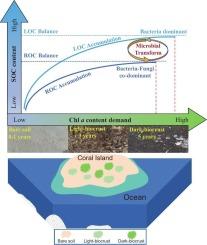Biocrusts facilitate organic carbon preservation in tropical coral islands undergoing primary succession
IF 6.6
1区 农林科学
Q1 SOIL SCIENCE
引用次数: 0
Abstract
Tropical coral islands, often regarded as ‘oceanic deserts’, undergo primary succession mediated by biological soil crusts (biocrusts), which facilitate soil formation and regulate biogeochemical cycles. Despite their critical role in enhancing substrates essential for the tropical coral island development, the influence of biocrust successional stages on soil organic carbon composition, stability, and preservation remains poorly understood. In this study, we examined biocrust enzyme activity, microbial communities, and their role in soil organic carbon preservation and stabilization across three- and five-years development stages. As biocrusts developed on coral islands, recalcitrant organic carbon (ROC) content increased significantly, with semi-labile and ROC fractions increasing by 4.6-fold and 6.3-fold, respectively, highlighting the strong carbon-fixation capacity of biocrusts in calcareous sand on tropical coral islands. Notably, enhanced polyphenol oxidase and cellulase activity, driven by bacterial–fungal interactions, regulated ROC accumulation and preservation throughout biocrust development. Over the five-year developmental period, the levels of semi-labile and ROC in the calcareous sand increased quadratically with biocrust chlorophyll a (Chla). The maximum preserved ROC content occurred at a Chla content of 30.8 mg/kg, corresponding to 6.85 g/kg (dw) of ROC that could be sustainably stored in the calcareous sand. The preserved ROC effectively improving the carbon preservation potential of biocrusts within tropical coral island ecosystems. Overall, this study underscores the importance of understanding biocrust formation and development and its influence on the carbon cycle, providing valuable insights into the management of tropical coral island ecosystems.

生物结壳促进了原生演替过程中热带珊瑚岛有机碳的保存
通常被视为“海洋沙漠”的热带珊瑚岛经历了由生物土壤结壳介导的初级演替,生物土壤结壳促进了土壤的形成并调节了生物地球化学循环。生物结壳演替阶段对土壤有机碳组成、稳定性和保存的影响尚不清楚,但它们在增强热带珊瑚岛发展所必需的基质方面发挥着关键作用。在这项研究中,我们研究了生物硬壳酶活性、微生物群落及其在土壤有机碳保存和稳定中的作用,这些作用在3年和5年的发展阶段。随着珊瑚岛生物结壳的发育,顽固性有机碳(ROC)含量显著增加,其中半不稳定组分和ROC组分分别增加了4.6倍和6.3倍,凸显了热带珊瑚岛钙质砂生物结壳具有较强的固碳能力。值得注意的是,在细菌-真菌相互作用的驱动下,多酚氧化酶和纤维素酶活性的增强调节了生物外壳发育过程中ROC的积累和保存。在5年的发育期内,钙质砂中半不稳定态和ROC水平随生物结壳叶绿素a (Chla)呈二次增长。Chla含量为30.8 mg/kg时,保存的ROC含量最大,对应于钙质砂中可持续保存的ROC含量为6.85 g/kg (dw)。保存的ROC有效地提高了热带珊瑚岛生态系统生物结皮的碳保存潜力。总的来说,这项研究强调了了解生物结壳的形成和发展及其对碳循环的影响的重要性,为热带珊瑚岛生态系统的管理提供了有价值的见解。
本文章由计算机程序翻译,如有差异,请以英文原文为准。
求助全文
约1分钟内获得全文
求助全文
来源期刊

Geoderma
农林科学-土壤科学
CiteScore
11.80
自引率
6.60%
发文量
597
审稿时长
58 days
期刊介绍:
Geoderma - the global journal of soil science - welcomes authors, readers and soil research from all parts of the world, encourages worldwide soil studies, and embraces all aspects of soil science and its associated pedagogy. The journal particularly welcomes interdisciplinary work focusing on dynamic soil processes and functions across space and time.
 求助内容:
求助内容: 应助结果提醒方式:
应助结果提醒方式:


